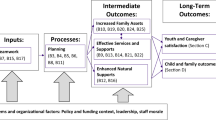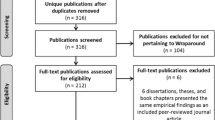Abstract
Research on wraparound services has been generally positive, but has failed to include data regarding treatment integrity. Without such data, conclusions drawn from such studies are weakened. This study followed 28 children and adolescents receiving wraparound services in rural central Pennsylvania. Treatment integrity was defined as the percentage of service hours prescribed vs. received, and behavioral outcomes were defined as Total Problem Behavior T Scores on the Child Behavior Checklist. Preliminary analyses failed to reveal significant differences in sample means between included subjects and those excluded due to missing data. Outcome behavior ratings were significantly improved over baseline ratings. Regression analyses, however, failed to find a significant effect for treatment integrity when used in an outcome prediction equation for Therapeutic Support Staff, Mobile Therapy services, or Behavioral Specialist wraparound services. These results suggest that adherence to prescribed treatment hours may not be related to behavioral outcomes in a wraparound service setting.
Similar content being viewed by others
REFERENCES
Achenbach, T. & Edelbrock, C. (1991). Manual for the Child Behavior Checklist/ 4–18. Burlington, VT: University of Vermont, Department of Psychiatry.
Bruns, E., Burchard, J., & Yoe, J. (1995). Evaluating the Vermont system of care: Outcomes associated with community-based wraparound services. Journal of Child and Family Studies, 4, 321–339.
Burchard, J., Burchard, S., Sewell, R., & VanDenBerg, J. (1993). One kid at a time: Evaluative case studies and description of the Alaska youth initiative demonstration project. National Technical Assistance Center for Children's Mental Health. Center for Child Health and Mental Health Policy, Georgetown University Child Development Center.
Clark, H., Lee, B., Prange, M., & McDonald, B. (1996). Children lost within the foster care system: Can wraparound services improve placement outcomes? Journal of Child and Family Studies, 5, 39–54.
Clarke, R., Schaefer, M., Burchard, J., & Welkowitz, J. (1992). Wrapping community-based mental health services around children with a severe behavioral disorder: An evaluation of project wraparound. Journal of Child and Family Studies, 1, 241–261.
Eber, L., Osuch, R., & Reddit, C. (1996). School-based applications of the wraparound process: Early results on service provision and student outcomes. Journal of Child and Family Studies, 5, 83–89.
Gresham, F.M. (1989). Assessment of treatment integrity in school consultation and prereferral intervention. School Psychology Review, 18, 37–50.
Gresham, F., Gansle, K., & Noell, G. (1993). Treatment integrity in applied behavior analysis with children. Journal of Applied Behavior Analysis, 26, 257–263.
Hollin, C.R. (1995). The meaning and implications of 'Programme integrity'. In J. McGuire (Ed.). What works: Reducing reoffending (pp. 195–208). New York: John Wiley & Sons.
Johnson, V.S. (1981). Staff drift: A problem in program integrity. Criminal Justice and Behavior, 8, 223–232.
Judd, C. & McClelland, G. (1989). Data analysis: A model comparison approach. San Diego, CA: Harcourt-Brace Jovanovich, Inc.
Kutash, K., Duchnowski, A., Sondheimer, D. (1994). Building the research base for children's mental health services: Special series: Center for mental health service research projects. Journal of Emotional and Behavior Disorders, 2, 55–67.
Luborsky L. & DeRubeis, R. (1984). The use of psychotherapy treatment manuals: A small revolution in psychotherapy research style. Clinical Psychology Review, 4, 5–14.
Moncher, F. & Prinz, R. (1991). Treatment fidelity in outcome studies. Clinical Psychology Review, 11, 247–266.
Peterson, L., Homer, A., & Wonderlich, S. (1982). The integrity of independent variables in behavior analysis. Journal of Applied Behavior Analysis, 15, 477–492.
Rosenblatt, A. (1996). Bows and ribbons, tape and twine: Wrapping the wraparound process for children with multi-system needs. Journal of Child and Family Studies, 5, 101–116.
Salend, S.J. (1984). Therapy outcome research: Threats to treatment integrity. Behavior Modification, 8, 211–222.
VanDenBerg, J.E. (1993). Integration of individualized mental health services into the system of care for children and adolescents. Administration and Policy in Mental Health, 20, 247–257.
Author information
Authors and Affiliations
Rights and permissions
About this article
Cite this article
Toffalo, D.A.D. An Investigation of Treatment Integrity and Outcomes in Wraparound Services. Journal of Child and Family Studies 9, 351–361 (2000). https://doi.org/10.1023/A:1026496524181
Issue Date:
DOI: https://doi.org/10.1023/A:1026496524181




